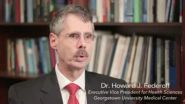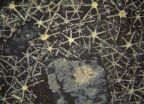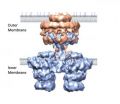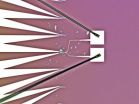(Press-News.org) Farmed salmon show full reproductive potential to invade wild gene pools and should be sterilised - according to new research from the University of East Anglia (UEA).
Findings published today reveal that, while farmed salmon are genetically different to their wild counterparts, they are just as fertile. This is important information because millions of farmed salmon escape into the wild – posing threats to wild gene pools.
Lead Researcher Prof Matt Gage from UEA's school of Biological Sciences said: "Around 95 per cent of all salmon in existence are farmed, and domestication has made them very different to wild populations, each of which is locally adapted to its own river system.
"Farmed salmon grow very fast, are aggressive, and not as clever as wild salmon when it comes to dealing with predators. These domestic traits are good for producing fish for the table, but not for the stability of wild populations.
"The problem is that farmed salmon can escape each year in their millions, getting into wild spawning populations, where they can then reproduce and erode wild gene pools, introducing these negative traits.
"We know that recently-escaped farmed salmon are inferior to wild fish in reproduction, but we do not have detailed information on sperm and egg performance, which could have been affected by domestication. Our work shows that farm fish are as potent at the gamete level as wild fish, and if farm escapes can revive their spawning behaviour by a period in the wild, clearly pose a significant threat of hybridisation with wild populations."
Researchers used a range of in vitro fertilization tests in conditions that mimicked spawning in the natural environment, including tests of sperm competitiveness and egg compatibility. All tests on sperm and egg form and function showed that farmed salmon are as fertile as wild salmon – identifying a clear threat of farmed salmon reproducing with wild fish.
"Some Norwegian rivers have recorded big numbers of farmed fish present – as much as 50 per cent. Both anglers and conservationists are worried by farmed fish escapees which could disrupt locally adapted traits like timing of return, adult body size, and disease resistance.
"Salmon farming is a huge business in the UK, Norway and beyond, and while it does reduce the pressure on wild fish stocks, it can also create its own environmental pressures through genetic disruption.
"A viable solution is to induce 'triploidy' by pressure-treating salmon eggs just after fertilisation - where the fish grows as normal, but with both sex chromosomes; this is normal for farming rainbow trout. The resulting adult develops testes and ovaries but both are much reduced and most triploids are sterile. These triploid fish can't reproduce if they escape, but the aquaculture industry has not embraced this technology yet because of fears that triploids don't perform as well in farms as normal diploid fish, eroding profits."
INFORMATION:
This research was funded by the Natural Environment Research Council (NERC) and the Royal Society.
'Assessing risks of invasion through gamete performance: farm Atlantic salmon sperm and eggs show equivalence in function, fertility, compatibility and competitiveness to wild Atlantic salmon' is published by Evolutionary Applications on March 10, 2014.
Farm salmon pose clear reproductive threat to wild gene pools
2014-03-10
ELSE PRESS RELEASES FROM THIS DATE:
UEA research reveals 4 new man-made gases in the atmosphere
2014-03-09
Scientists at the University of East Anglia have identified four new man-made gases in the atmosphere – all of which are contributing to the destruction of the ozone layer.
New research published today in the journal Nature Geoscience reveals that more than 74,000 tonnes of three new chlorofluorocarbons (CFCs) and one new hydrochlorofluorocarbon (HCFC) have been released into the atmosphere.
Scientists made the discovery by comparing today's air samples with air trapped in polar firn snow – which provides a century-old natural archive of the atmosphere. They also looked ...
Blood test identifies those at-risk for cognitive decline, Alzheimer's within 3 years
2014-03-09
VIDEO:
Howard J. Federoff, M.D., Ph.D., of Georgetown University Medical Center, explains a new blood test that can predict onset of MCI or Alzheimer's.
Click here for more information.
WASHINGTON — Researchers have discovered and validated a blood test that can predict with greater than 90 percent accuracy if a healthy person will develop mild cognitive impairment or Alzheimer's disease within three years.
Described in Nature Medicine published online today, the study heralds ...
Mutations in leukemia gene linked to new childhood growth disorder
2014-03-09
Mutations in a gene associated with leukaemia cause a newly described condition that affects growth and intellectual development in children, new research reports.
A study led by scientists at The Institute of Cancer Research, London, identified mutations in the DNA methyltransferase gene, DNMT3A, in 13 children.
All the children were taller than usual for their age, shared similar facial features and had intellectual disabilities. The mutations were not present in their parents, nor in 1,000 controls from the UK population.
The new condition has been called 'DNMT3A ...
First animals oxygenated the ocean, study suggests
2014-03-09
The evolution of the first animals may have oxygenated the earth's oceans – contrary to the traditional view that a rise in oxygen triggered their development.
New research led by the University of Exeter contests the long held belief that oxygenation of the atmosphere and oceans was a pre-requisite for the evolution of complex life forms.
The study, published today in the leading journal Nature Geoscience, builds on the recent work of scientists in Denmark who found that sponges – the first animals to evolve – require only small amounts of oxygen.
Professor Tim ...
In grasslands remade by humans, animals may protect biodiversity
2014-03-09
COLLEGE PARK, Maryland – A comparative study of grasslands on six continents suggests there may be a way to counteract the human-made overdose of fertilizer that threatens to permanently alter the biodiversity of the world's native prairies.
The solution is one that nature devised: let grazing animals crop the excess growth of fast growing grasses that can out-compete native plants in an over-fertilized world. And grazing works in a way that is also natural and simple. The herbivores, or grazing and browsing animals, feed on tall grasses that block sunlight from reaching ...
New bioinformatics tool to visualize transcriptomes
2014-03-09
ZENBU, a new, freely available bioinformatics tool developed at the RIKEN Center for Life Science Technology in Japan, enables researchers to quickly and easily integrate, visualize and compare large amounts of genomic information resulting from large-scale, next-generation sequencing experiments.
Next-generation sequencing has revolutionized functional genomics, with protocols such as RNA-seq, ChIP-seq and CAGE being used widely around the world. The power of these techniques lies in the fact that they enable the genome-wide discovery of transcripts and transcription ...
Sun's energy influences 1,000 years of natural climate variability in North Atlantic
2014-03-09
Changes in the sun's energy output may have led to marked natural climate change in Europe over the last 1000 years, according to researchers at Cardiff University.
Scientists studied seafloor sediments to determine how the temperature of the North Atlantic and its localised atmospheric circulation had altered. Warm surface waters flowing across the North Atlantic, an extension of the Gulf Stream, and warm westerly winds are responsible for the relatively mild climate of Europe, especially in winter. Slight changes in the transport of heat associated with these systems ...
Spread of antibiotic resistance understood by unravelling bacterial secretion system
2014-03-09
The system that allows the sharing of genetic material between bacteria – and therefore the spread of antibiotic resistance – has been uncovered by a team of scientists at Birkbeck, University of London and UCL.
The study, published today in Nature, reveals the mechanism of bacterial type IV secretion, which bacteria use to move substances across their cell wall. As type IV secretion can distribute genetic material between bacteria, notably antibiotic resistance genes, the mechanism is directly responsible for the spread of antibiotic resistance in hospital settings. ...
Atomically thin solar cells
2014-03-09
It does not get any thinner than this: The novel material graphene consists of only one atomic layer of carbon atoms and exhibits very special electronic properties. As it turns out, there are other materials too, which can open up intriguing new technological possibilities if they are arranged in just one or very few atomic layers. Researchers at the Vienna University of Technology have now succeeded for the first time in creating a diode made of tungsten diselenide. Experiments show that this material may be used to create ultrathin flexible solar cells. Even flexible ...
U of M-led study finds herbivores can offset loss of plant biodiversity in grassland
2014-03-09
Two wrongs may not make a right. But when it comes to grassland plant species diversity, it just might. Two impacts often controlled by humans — being fertilized and being eaten — can combine to the benefit of biodiversity, according to an innovative international study led by U of M researchers Elizabeth Borer and Eric Seabloom.
The findings, published March 9 in the online edition of Nature in advance of print publication, are important in a world where humans are changing both herbivore distribution and the supply of nutrients like nitrogen or phosphorus, and where ...





